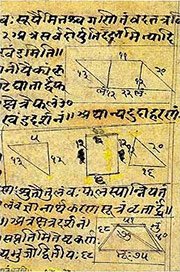Sadamsha, Sadaṃśa, Ṣaḍaṃśa, Shadamsha: 5 definitions
Introduction:
Sadamsha means something in Hinduism, Sanskrit. If you want to know the exact meaning, history, etymology or English translation of this term then check out the descriptions on this page. Add your comment or reference to a book if you want to contribute to this summary article.
The Sanskrit terms Sadaṃśa and Ṣaḍaṃśa can be transliterated into English as Sadamsa or Sadamsha or Shadamsha, using the IAST transliteration scheme (?).
In Hinduism
Ganitashastra (Mathematics and Algebra)
Source: archive.org: Hindu MathematicsṢaḍaṃśa (षडंश) or Ṣaḍbhāga refers to “six-parts” (i.e., one-sixth) in Bhinna (“fractions”) and Bhāga (“unit fractions”), which refers to one of the twenty operations (logistics) of pāṭīgaṇita (“science of calculation which requires the use of writing material—the board”), according to Pṛthudakasvāmī’s commentary on the Brāhmasphuṭasiddhānta by Brahmagupta, a Sanskrit treatise on ancient Indian mathematics (gaṇita-śāstra) and astronomy from the 7th century.—In the Śulba, unit fractions are denoted by the use of a cardinal number with the term bhāga or aṃśa; thus pañcadaśa-bhāga (“fifteen-parts”) is equivalent to one-fifteenth, sapta-bhāga (“seven-parts”) is equivalent to one-seventh, and so on [e.g., ṣaḍaṃśa].

Ganitashastra (शिल्पशास्त्र, gaṇitaśāstra) refers to the ancient Indian science of mathematics, algebra, number theory, arithmetic, etc. Closely allied with astronomy, both were commonly taught and studied in universities, even since the 1st millennium BCE. Ganita-shastra also includes ritualistic math-books such as the Shulba-sutras.
Languages of India and abroad
Sanskrit dictionary
Source: DDSA: The practical Sanskrit-English dictionarySadaṃśa (सदंश).—A crab.
Derivable forms: sadaṃśaḥ (सदंशः).
Source: Cologne Digital Sanskrit Dictionaries: Cappeller Sanskrit-English DictionaryṢaḍaṃśa (षडंश).—[masculine] one sixth; adj. sixfold.
Source: Cologne Digital Sanskrit Dictionaries: Monier-Williams Sanskrit-English Dictionary1) Ṣaḍaṃśa (षडंश):—[=ṣaḍ-aṃśa] [from ṣaḍ > ṣaṣ] m. a sixth part, [Raghuvaṃśa]
2) [v.s. ...] mfn. consisting of six parts (-tā f.), [Sarvadarśana-saṃgraha]
3) Sadaṃśa (सदंश):—[=sa-daṃśa] mfn. (id est. 7. sa+d) having a sharp beak or bill
[Sanskrit to German]
Sanskrit, also spelled संस्कृतम् (saṃskṛtam), is an ancient language of India commonly seen as the grandmother of the Indo-European language family (even English!). Closely allied with Prakrit and Pali, Sanskrit is more exhaustive in both grammar and terms and has the most extensive collection of literature in the world, greatly surpassing its sister-languages Greek and Latin.
See also (Relevant definitions)
Partial matches: Amsha, Damsha, Shash, Sha, Sat, Ca.
Starts with: Sadamshaka, Sadamshavadana.
Full-text (+41): Sadamshavadana, Shadamshata, Sadashanarcis, Sadinam, Sadasharatha, Sadattva, Sadurdina, Sadarpam, Sadevatva, Sadikshopasatka, Sadevaka, Sadaham, Sadayam, Sadaivata, Sadadhan, Sadevika, Sadarpa, Sadayatva, Sadurva, Saduhkha.
Relevant text
Search found 3 books and stories containing Sadamsha, Sadaṃśa, Sa-damsha, Sad-amsa, Ṣaḍ-aṃśa, Shad-amsha, Sadamsa, Ṣaḍaṃśa, Shadamsha, Sa-daṃśa, Sa-damsa, Ṣaṣ-aṃśa, Shas-amsha, Sas-amsa; (plurals include: Sadamshas, Sadaṃśas, damshas, amsas, aṃśas, amshas, Sadamsas, Ṣaḍaṃśas, Shadamshas, daṃśas, damsas). You can also click to the full overview containing English textual excerpts. Below are direct links for the most relevant articles:
Trishashti Shalaka Purusha Caritra (by Helen M. Johnson)
Notes on the maṇi-jewl < [Notes]
The Brahma Purana (by G. P. Bhatt)
Kashyapa Shilpa-shastra (study) (by K. Vidyuta)
5. Measurement for the Storeys of the Gopuras < [Chapter 5 - Gopura Lakṣaṇa]